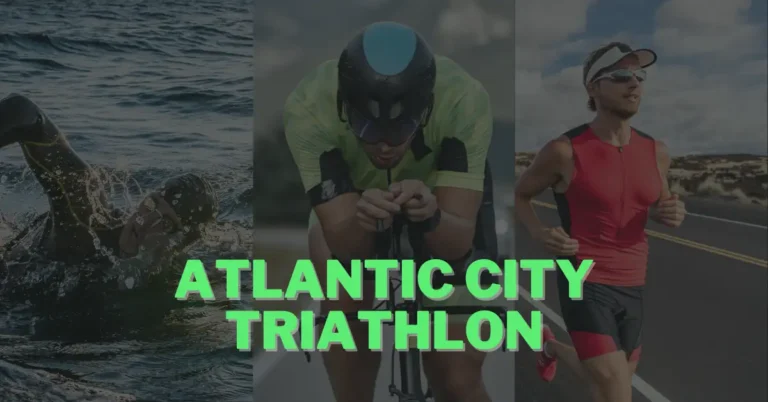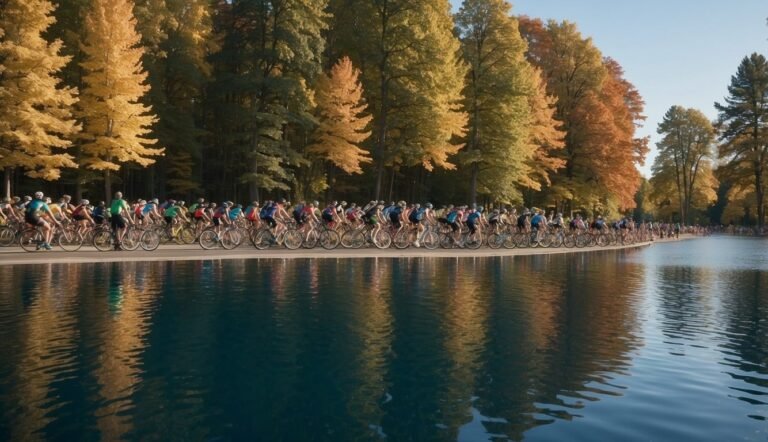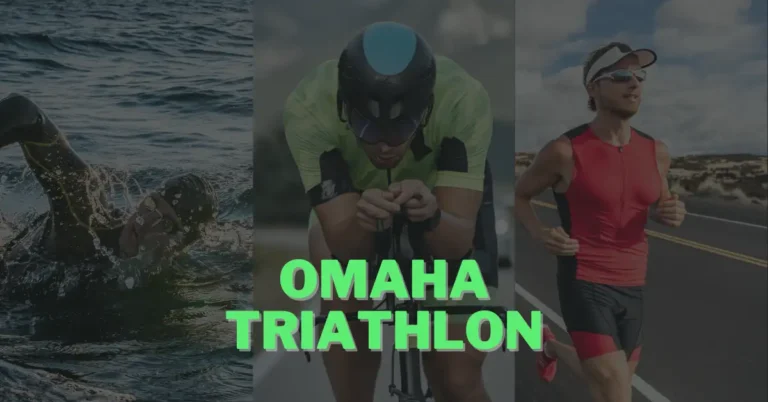📦 FREE Shipping
Super Sprint Triathlon 2024: Quick Guide to Your First Race!

I’ve recently discovered the world of triathlons, and I must tell you, there’s something incredibly invigorating about the challenge and variety they offer. For those looking to dip their toes in the waters of this multisport event, the super sprint triathlon stands out as the perfect starting point.
It’s an entry-level distance that seems to be reaching new heights in popularity, not just in the USA, but globally. Its manageable distances are right up my alley, and I’m excited about the thought of swimming, biking, and running alongside fellow beginners as well as seasoned athletes who are there for the love of the sport.

The super sprint triathlon consists of a 400-meter swim, a 10-kilometer bike ride, and a 2.5-kilometer run. I find this shorter distance not only appealing but also quite doable for someone just starting out like me. International attention on triathlons is certainly heating up with events like the Paris 2024 Olympics on the horizon, and the super sprint distance provides a fantastic opportunity for amateurs to get a taste of the triathlon world. I’m intrigued by events popping up all across the USA, like in Whitewater, WI with the J-Hawk Earlybird Triathlon and in Bath, PA with the Evergreen Lake Super Sprint Triathlon, both slated for 2024.
Embracing the challenge, I’ve marked my calendar with some potential races. The inclusion of super sprint triathlons as sanctioned events by World Triathlon signifies its growing reputation. If you ask me, the notion that I could join the triathlon community through such exhilarating yet manageable events feels nothing short of thrilling. To all the fellow beginners considering a super sprint triathlon, I say, let’s take the plunge together and experience the rush of our first multisport event!
Essential Super Sprint Triathlon Elements
I’m thrilled to share the core aspects of a super sprint triathlon, an exhilarating and fast-paced distance event sure to ignite your competitive spirit. Let’s dive into what makes up this dynamic triathlon segment by segment.
Swim Stage
The swim kicks off the adventure. In a super sprint triathlon, the swim distance is typically a quick 400m, although some events might shorten it to 300m. It’s a pulse-pounding start either in a pool or open water. Wearing a wetsuit may be advisable, depending on the water temperature. Speed and efficiency in the water set the tone for the rest of the race.
Bike Stage
Next, we hit the cycling portion. The bike stage usually spans a swift 10km, where drafting skills can be crucial in draft-legal events. A super sprint bike ride is where I really focus on pushing my endurance and speed, knowing it’s a shorter distance than the traditional sprint. My bike training involves both intensity for speed and distance for stamina.
Run Stage
Finally, the run stage is a fast 2.5km, though some events might offer a slightly shorter 1.75km distance. This is where I dig deep to sprint through to the finish. My training on the run focuses on maintaining pace after biking, which is essential in a triathlon. It’s all about that final burst of speed for an impressive finish.
Training and Preparation for a Super Sprint Triathlon

Embarking on the journey of a super sprint triathlon is electrifying! My fitness levels will soar as I dive into running, swimming, and biking. With the right plan, nutrition, rest, and gear, I’m on the road to my best performance.
Developing a Training Plan
I understand that I need to balance training time across all three disciplines to boost my overall fitness efficiently. A typical weekly plan for a beginner might look like this:
- Monday: Rest day to recover and build endurance.
- Tuesday:
- Swim: 12x75m, alternating pace
- Bike: Low intensity, focusing on technique
- Wednesday:
- Run: 40 minutes on rolling terrain, varying intensity
- Thursday:
- Bike: 60 minutes, integrating hill work for strength
- Friday: Rest day or light swimming
- Saturday:
- Run/Bike brick session to simulate race day
- Sunday:
- Open water swim in a wetsuit for realism
This plan should include increased intensity leading up to the race but taper down just before to ensure I’m not overexhausted. A coach can help customize my training schedule to fit my needs and abilities perfectly.
Nutrition and Rest
What I eat and how much I rest are pivotal. My focus:
- Carbs for energy during long training sessions.
- Proteins post-workout to aid muscle recovery.
- Hydration: Keeping water levels topped up is critical!
Rest is as important as the workout. I’ll aim for 7-9 hours of sleep and listen to my body for extra rest days if needed. Overtraining is a real concern and counterproductive.
Gear and Equipment
Investing in quality gear is a non-negotiable for athletes:
- Wetsuit: Needs to be flexible for swimming and provide warmth in open water.
- Bike: A comfortable, well-fitted bike to minimize fatigue.
- Running Shoes: Proper fit to prevent injury with good cushioning and support.
I’ll prioritize the fit and comfort of my gear to not only improve performance but also prevent injuries..multipart
This section of my article sets me up for success, guiding me through the creation of a balanced training plan, the importance of nutrition and rest, and selecting the right gear for an upcoming super sprint triathlon. Each component is a critical piece of the puzzle that will help me reach my goals.
Participating in Events
I’m always thrilled to share the ins and outs of participating in super sprint triathlon events. From locating the perfect race to the buzz of race day and the satisfying community involvement post-race, each phase is an exhilarating part of the journey.
Finding and Registering for Races
Identifying the Right Event: I check the USA Triathlon event calendar and search for Super Sprint races. These are perfect for me as an entry-level athlete, with distances I can manage: a 400m swim, a 10km cycle, followed by a 2.5km run. TriathlonLive.tv and the Super League Triathlon offer information on various events, too, including qualifiers and triathlon festivals.
Registration Process: Once I’ve selected a race such as the Waupaca Area Triathlon on August 17, 2024, I register online. Most events in the USA have clear instructions, and the cost is usually upfront. It’s also where I choose whether I’m going solo or participating in a relay.
Understanding Race Day Dynamics
Start Line: I set realistic goals for myself. Do I want to beat my previous time, or just finish the race? On race day, transitions are crucial; I’ve practiced switching from swimming to cycling, then from cycling to running, making sure each transition is seamless and swift.
The Course: Familiarizing myself with the course layout beforehand is essential, especially when it’s in a vibrant city centre like Montreal or Abu Dhabi. TriathlonLive.tv often streams events, so I can even preview races like the World Triathlon Series.
After the Race: Recovery and Community
Post-Race Rest: Once I’ve crossed that finish line, I focus on rest. My body needs it after the exertion, and I take some time to reflect on my performance and the goals I achieved.
Joining the Community: Following the race, I connect with fellow athletes like Summer Rappaport or Hayden Wilde. Even if I can’t meet them in person, social media and TriathlonLive.tv help me engage with the triathlon community, sharing experiences and tips with others who love the sport as much as I do.
Frequently Asked Questions about Super Sprint Triathlon
I’m here to answer some of the most common queries curious triathletes have about super sprint triathlons. Dive into these FAQs to get a head start on your super sprint journey!
How do I train effectively for a super sprint triathlon?
Training for a super sprint triathlon typically requires dedicating around 3-4 hours each week to develop your swimming, cycling, and running abilities. Balancing these disciplines is key to building a rounded skill set.
What are the typical distances involved in a super sprint triathlon?
A super sprint triathlon generally consists of a 400m swim, a 10km bike ride, and a 2.5km run. However, distances may vary slightly depending on the event.
Where can I find super sprint triathlon events happening this year?
To find super sprint triathlon events, I look at local triathlon club websites, sports event listings, or national triathlon organizations for the most up-to-date schedules.
What are the average finish times for different age groups in a super sprint triathlon?
The average finish times for a super sprint triathlon can range between 0.5-1 hour. Finish times can vary significantly across different age groups due to variations in performance levels.
What should my training plan look like for a super sprint triathlon?
My training plan includes a mix of swimming, cycling, and running sessions, each tailored to improve speed and endurance. I focus on shorter, more intense workouts to prepare for the fast-paced nature of a super sprint.
Where can I find results of past super sprint triathlon events?
To find past event results, I check the official event websites or the hosting organization’s results page. These resources typically provide a detailed breakdown of timings across all participant categories.
Was it interesting to read about the Super Sprint Triathlon? Write me a comment. You can read about an Olympic Triathlon Training Plan or Carolina Triathlon after.





